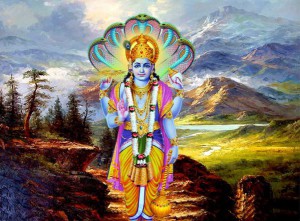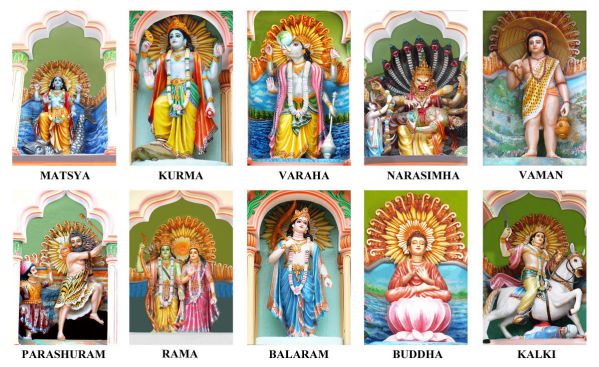No products in the cart.
Dashavatar – Hindu Gods and Deities
 Dashavatara refers to the ten avatars of Vishnu, the Hindu god of preservation. The word Dashavatara derives from daśa, meaning ‘ten’ and avatar (avatāra), meaning ‘descent’. Thus, Vishnu is said to descend in form of an avatar to restore cosmic order. These Avatars play a major role in shaping human evolution through centuries. God Vishnu incarnates on Earth from time to time to eradicate evil forces, to restore the dharma and to liberate the worthy ones or devotees from the cycle of births and deaths.
Dashavatara refers to the ten avatars of Vishnu, the Hindu god of preservation. The word Dashavatara derives from daśa, meaning ‘ten’ and avatar (avatāra), meaning ‘descent’. Thus, Vishnu is said to descend in form of an avatar to restore cosmic order. These Avatars play a major role in shaping human evolution through centuries. God Vishnu incarnates on Earth from time to time to eradicate evil forces, to restore the dharma and to liberate the worthy ones or devotees from the cycle of births and deaths.
The first four avatars of Vishnu appeared in Satya or Krita Yuga, the first of the four Yugas, also called ‘The Golden Age’. The next three appeared in Treta Yuga, the eighth and ninth in Dwapara Yuga and the tenth will appear in Kali Yuga. The time till completion for Kali Yuga is in 427,000 years. In the Vishnu Purana and the Bhagavata Purana, the Kali-yuga is described as ending with the appearance of Kalki, who will defeat the wicked, liberate the virtuous, and initiate a new Satya or Kalki Yuga.
The list of Dashavatara varies across sects and regions. The standard list is: Matsya, Kurma, Varaha, Narasimha, Vamana, Parashurama, Rama, Krishna, Buddha and Kalki. Sometimes, Krishna replaces Vishnu as the source of all avatars and Balarama takes Krishna’s place in the list. In other versions, Buddha may be dropped from the list and substituted by regional deities like Vithoba or Jagannath, or Balarama. Different Traditions list the avatars differently. The most accepted list of avatars is as follows:
Matsya (Fish)
A Satya Yuga Avatar
When the world was at the brink of extinction Manu was instructed by God to rescue the life form on earth, he chooses 1 male and 1 female from every species, also collects plants of different species and loads them all on the big ship he had already built. The whole world was washed up in rain and as a result there was no land to stay.
A fish (matsya) with horns comes to the rescue. The ship was tied to the horn of the fish, the fish pulls the ship with great speed towards the himalayas where there was a small island for all the life forms to gradually grow and increase in number.
Kurma (Tortoise)
A SatyaYuga Avatar
When the devas and asuras were churning the Ocean of milk in order to get amrita, the nectar of immortality, with serpent Vasuki as the rope and the mount Mandara as the churning staff, the mountain starts to sink, Vishnu took the form of a tortoise to bear the weight of the mountain.
Varaha (Boar)
A SatyaYuga Avatar
When the demon Hiranyaksha stole the earth (goddess Bhudevi) and hid her in the primordial waters, Vishnu appeared as Varaha to rescue her. The battle between Varaha and Hiranyaksha is believed to have lasted for a thousand years. Varaha finally slew the demon and retrieved the Earth from the ocean, lifting it on his tusks, and restored Bhudevi to her place in the universe.
In the Vishnu Purana, Varaha represents yajna (sacrifice), as the eternal upholder of the earth. His feet represent the Vedas (scriptures). His tusks represent sacrificial stakes. His teeth are offerings. His mouth is the altar with tongue of sacrificial fire. The hair on his head denotes the sacrificial grass. The eyes represent the day and the night. His coarse hair represents sexual prowess. The head represents the seat of the Brahmin (priest). The mane represents the hymns of the Vedas. His nostrils are for oblation. His joints represent the various ceremonies. The ears are said to indicate rites (voluntary and obligatory). Thus, Varaha is the embodiment of the Supreme Being who brings order amidst chaos in the world by his sacrifice
Narasimha ( half-man/half-lion)
A SatyaYuga Avatar
The younger brother of Hirṇayakṣa, Hiraṇyakaśipu wanted revenge on Viṣṇu and his followers. He undertook many years of austere penance to take revenge on Viṣṇu for the death of his brother. Brahma thus offers the demon a boon and Hiraṇyakaśipu asks for immortality. Brahma tells him this is not possible, but that he could bind the death of Hiraṇyakashipu with conditions.
Hranyakashipu asks that he not be killed by man or animal, inside or out, day or night, on earth or the stars, with a weapon either living or inanimate.
Vishnu descended as an anthropomorphic incarnation, with the body of a man and head and claws of a lion. He then disembowels the rakshasa at the courtyard threshold of his house, at dusk, with his claws, while he lay on his thighs.
Vamana (Dwarf)
A Treta yuga Avatar
The fourth descendant of Hiranyakashyap, Bali, with devotion and penance was able to defeat Indra, the god of firmament. This humbled the other deities and extended his authority over the three worlds. The gods appealed to Vishnu for protection and he descended as the dwarf Vamana. During a yajna of the king, Vamana approached him and Bali promised him for whatever he asked. Vamana asked for three paces of land. Bali agreed, and the dwarf then changed his size to that of a giant. He stepped over heaven in his first stride, and the netherworld with the second. Bali realized that Vamana was Vishnu incarnate. In deference, the king offered his head as the third place for Vamana to place his foot. The avatar did so and thus granted Bali immortality. Then in appreciation to Bali and his grandfather Prahlada, Vamana made him ruler of Pathala, the netherworld.
Vamana taught King Mahabali that pride should be abandoned for advancement in life, and that wealth should be appreciated as it can easily disappear.
Parshuram
A Treta yuga Avatar
Parshuram or Parashurama, the warrior with the axe. He is son of Jamadagni and Renuka and received an axe after a penance to Shiva. He is the first Brahmin-Kshatriya in Hinduism, or warrior-saint, with duties between a Brahmana and a Kshatriya. King Kartavirya Arjuna and his army visited the father of Parashurama at his ashram, and the saint was able to feed them with the divine cow Kamadhenu. The king demanded the animal, Jamadagni refused, and the king took it by force and destroyed the ashram. Parashurama then killed the king at his palace and destroyed his army. In revenge, the sons of Kartavirya killed Jamadagni. Parashurama took a vow to kill every Kshatriya on earth twenty-one times over, and filled five lakes with their blood. Ultimately, his grandfather, rishi Rucheeka, appeared and made him halt. He is a Chiranjivi (immortal), and believed to be alive today in penance at Mahendragiri.
Parashurama is most known for ridding the world of kshatriyas twenty-one times over after the mighty king Kartavirya killed his father. He played important roles in the Mahabharata and Ramayana, serving as mentor to Bhishma, Karna and Drona. Parashurama also fought back the advancing seas to save the lands of Konkan, Malabar and Kerala. He is one of the seven immortals mentioned in the scriptures.
Rama
A Treta yuga Avatar
The prince and king of Ayodhya. Rama’s life and journey is one of adherence to dharma despite harsh tests and obstacles and many pains of life and time. He is pictured as the ideal man and the perfect human. For the sake of his father’s honour, Ram abandons his claim to Ayodhaya’s throne to serve an exile of fourteen years in the forest.
While in exile from his own kingdom with his brother Lakshman and the monkey king Hanuman, his wife Sita was abducted by the demon king of Lanka, Ravana. He travelled to Ashoka Vatika in Lanka, killed the demon king and saved Sita.
Krishna
A Dwapara Yuga Avatar
Krishna was the eighth son of Devaki and Vasudev, from the Dwapara Yuga. He is also a frequently worshiped deity in Hinduism and an avatar in Vaishnava belief. He appeared alongside his elder brother Balarama. Balarama is regarded generally as an avatar of Shesha. However, Balarama is included as the eighth avatar of Vishnu in the Sri Vaishnava lists, where Buddha is omitted and Krishna appears as the ninth avatar in this list. He particularly included in the lists, where Krishna is removed and becomes the source of all avatars.
Buddha (Gautama Buddha)
A Kali Yuga Avatar
When the world had lost real understanding of the scriptures and was stooped in ignorance (practices without right philosophy), Buddha an enlightened man reiterated the importance of self-realization and self-effort in realizing oneself.
He was responsible for changing the course of Hinduism towards the philosophy of Liberation away from the philosophy of heaven and hell
He was the founder of Buddhism, is generally included as an avatar of Vishnu in Hinduism. Buddha may be depicted in Hindu scriptures as a preacher who deludes and leads demons and heretics away from the path of the Vedic scriptures. Another view praises him as a compassionate teacher who preached the path of ahimsa (non-violence).
Kalki (destroyer of darkness)
A Kali Yuga Avatar
Kalki (“Eternity”, or “White Horse”, or “Destroyer of Filth”), will be the final incarnation of Vishnu, foretold to appear at the end of Kali Yuga, our present epoch. He will be atop a white horse and his sword will be drawn, blazing like a comet. He is the harbinger of end time in Hindu eschatology, and will destroy all unrighteousness and evil at the end of Kali Yuga.


